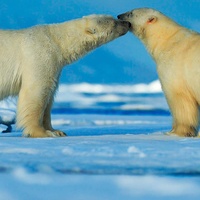Pesquise entre vários professores de Inglês...
AnatolyG•VoiceUnlock
Professor ProfissionalIELTS Reading. Part 1.
Why we need to protect polar bears.
Polar bears are being increasingly threatened by the effects of climate change, but their disappearance could have far-reaching consequences. They are uniquely adapted to the extreme conditions of the Arctic Circle, where temperatures can reach -40°C. One reason for this is that they have up to 11 centimetres of fat underneath their skin. Humans with comparative levels of adipose tissue would be considered obese and would be likely to suffer from diabetes and heart disease. Yet the polar bear experiences no such consequences.
A 2014 study by Shi Ping Liu and colleagues sheds light on this mystery. They compared the genetic structure of polar bears with that of their closest relatives from a warmer climate, the brown bears. This allowed them to determine the genes that have allowed polar bears to survive in one of the toughest environments on Earth. Liu and his colleagues found the polar bears had a gene known as APoB, which reduces levels of low-density lipoproteins (LDLs) – a form of ‘bad’ cholesterol. In humans, mutations of this gene are associated with increased risk of heart disease. Polar bears may therefore be an important study model to understand heart disease in humans.
Continue to read below.

IELTS READING: Polar Bears. Part 1.
18 de mai de 2022 06:01
Comentários · 2
3
The genome of the polar bear may also provide the solution for another condition, one that particularly affects our older generation: osteoporosis. This is a disease where bones show reduced density, usually caused by insufficient exercise, reduced calcium intake or food starvation. Bone tissue is constantly being remodelled, meaning that bone is added or removed, depending on nutrient availability and the stress that the bone is under. Female polar bears, however, undergo extreme conditions during every pregnancy. Once autumn comes around, these females will dig maternity dens in the snow and will remain there throughout the winter, both before and after the birth of their cubs. This process results in about six months of fasting, where the female bears have to keep themselves and their cubs alive, depleting their own calcium and calorie reserves. Despite this, their bones remain strong and dense.
19 de maio de 2022
thanks for this article.
19 de maio de 2022
AnatolyG•VoiceUnlock
Habilidades linguísticas
Inglês, Outros
Idioma de aprendizado
Outros
Artigos que Você Pode Gostar Também

🎃 October Traditions: Halloween, Holidays, and Learning Portuguese
34 votados positivos · 18 Comentários

The Curious World of Silent Letters in English
49 votados positivos · 26 Comentários

5 Polite Ways to Say “No” at Work
42 votados positivos · 12 Comentários
Mais artigos
